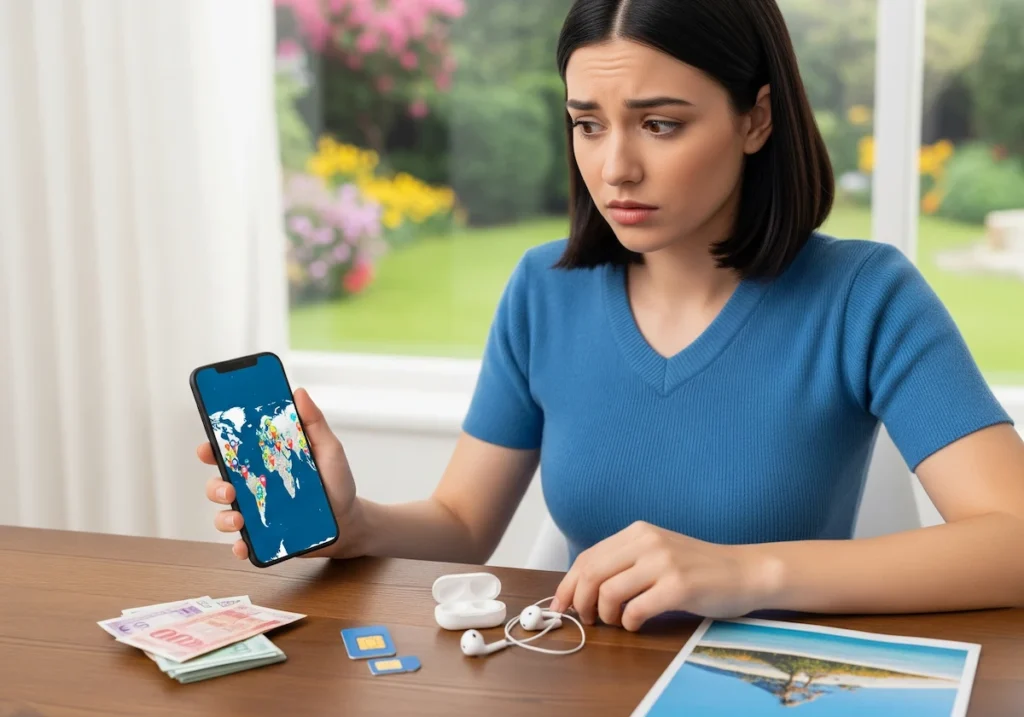We’ve all been there. You land overseas, turn on your phone, and suddenly you’re hit with roaming fees that could fund a short holiday.
A travel SIM or eSIM is your ticket to staying connected abroad without the shock of huge roaming charges when you return home. Popular options include Airalo, Nomad, and international plans from local carriers that let you use data, make calls, and send texts while travelling.
In this article, we’ll walk you through everything you need to know about staying connected without paying through the nose while travelling from Australia. You’ll learn:
- How eSIMs work and why they’re often your best bet
- The hidden traps in international roaming plans
- Best-value travel SIM options for different types of trips
- Steps to set up your connection before you fly
Let’s get you sorted so your next trip doesn’t come with any nasty surprises on your phone bill.
Main Differences: International Roaming, Local SIM, and eSIM
The main differences between international roaming, local SIM, and eSIM are cost, convenience, and setup complexity. Each option targets different types of travellers based on their budget and tech comfort level. Your choice will depend on how much data you need and how often you want to switch networks.
Here’s how each option works in practice:
Understanding the Options for Your Mobile Phone
You’ve got three main paths in Australia when it comes to staying connected overseas. You can stick with your current carrier’s international roaming (expensive), grab a local SIM when you land (time-consuming), or set up an eSIM before you go (the best option – convenient and affordable).
To make things simpler, most phones today are eSIM-ready and allow you to get connected in just a few taps. Often, this means you can sort everything out before you even leave home, which saves you the stress of hunting around foreign airports for SIM cards.
Your carrier might offer a day pass for internet access abroad, but these add up quickly on longer trips. Local SIM cards work differently because they give you a new number from that country, so calls and data work like you’re a resident. The downside is that people back home can’t reach you on your usual number unless you set up call forwarding.
Pro Tip: International roaming speeds vary depending on your carrier’s partnerships overseas. So it’s worth checking what your current provider offers before you fly.
Benefits and Drawbacks of Each Plan Type

Now that you know the options, let’s go through the pros and cons to help you choose what works best. A local SIM card gives you rock-bottom rates and works like you’re a local, but you’ll be juggling two phone numbers and hunting for shops that sell them.
Physical SIM cards can be tricky to swap out, too (and let’s be honest, who hasn’t lost one of those tiny things?). On the other hand, eSIMs are both convenient and flexible, because you can pay as you go without needing a physical card. It’s just a bit more expensive than local options, but the ease of setup and control often makes up for it.
As for cost, international roaming typically costs $5-10 per day for basic data allowances. But if you’re using local SIM cards, they usually run $10-30 for the entire trip, depending on how much data you need.
eSIM pricing varies quite a bit based on where you’re headed. For example, Yesim offers unlimited data plans starting from $1.80 per day in some countries, though popular destinations like Aruba can reach $15.60 daily. Other providers like Revolut keep things simple with global eSIM plans from around $2 per day.
The choice really comes down to your priorities and how much hassle you want to deal with. When you’re looking for hassle-free options, it’s worth checking which providers deliver what they promise and won’t leave you stranded without a signal.
How to Find the Best Travel SIM Deals in Australia
You can find the best travel SIM deals in Australia from major carriers like Telstra and Optus, plus specialist travel providers such as Airalo and Nomad. The trick is matching your travel style with the right network coverage and data allowances. Budget travellers often get the best value from MVNOs (mobile virtual network operators) that piggyback on the large networks but charge less.
Here’s what to look for based on your travel needs:
Top Providers for Extensive Coverage
Which provider gives you the best chance of staying connected in remote areas? Yes, you guessed it right! Telstra wins hands down for coverage, especially if you’re heading to rural spots or smaller towns. Their travel SIM options help you stay connected in places where other networks drop out completely.
Though the price is higher than other networks, you’re paying for reliability when you need it most. Think of it as travel insurance for your social media addiction.
These are your main options:
- Telstra: Best overall coverage, reaches 99.7% of the population
- Boost Mobile: Uses Telstra’s full network at lower prices
- Optus: Good urban coverage, weaker in remote areas
Boost Mobile is particularly good because you get Telstra’s network without paying Telstra’s prices. If you choose Optus, you’ll save money but might find yourself without a signal in country towns or national parks. It’s up to you whether you prioritise savings or complete coverage.
Budget-Friendly and City-Focused Plans

For cities and tourist hubs like Sydney, Melbourne, Brisbane, and the Gold Coast, the Optus network and Vodafone provide competitive data plans without the premium price tag. These networks work brilliantly in populated areas where most tourists spend their time anyway. You won’t miss much coverage while wandering around major cities, especially if you stick to tourist areas.
Besides, you can get a better deal by comparing different phone plans from providers on these networks. Smaller operators like Amaysim and TPG Mobile offer the same city coverage at much friendlier prices, typically ranging from $15-40 per month.
Also, many providers on these Optus and Vodafone networks have deals with unlimited data for limited periods. For example, Amaysim often runs promotions with unlimited data for the first month, while TPG Mobile offers generous data allowances for around $20-30 monthly. So you can stream your favourite shows without constantly checking your data balance.
The Best for Digital Nomads and Multi-Country Trips
Suppose you’re doing the classic Europe backpacker route, hitting six countries in three weeks. Your regular Australian SIM won’t work across all those borders without creating bill shock when you get home. As a solution to your multiple countries dilemma, global eSIM providers offer super flexible plans like Airalo‘s regional packages that cover entire continents.
And, to make things even easier, you can download an eSIM and have a plan ready before you even leave home. Most eSIM providers let you top up data as you go, so you’re never stuck without a connection. We know how stressful it feels when Google Maps stops working just as you’re trying to find your hotel or Airbnb in a new country.
Instead of juggling physical cards, data-only plans work as a good alternative to a physical SIM if you don’t need a local number for calls. You can still use WhatsApp, Telegram, or other apps for voice calls over your data connection. This setup works perfectly because you avoid the trouble of managing multiple phone numbers while still having all the connectivity you need.
Once you’ve picked your provider, the setup process is usually straightforward, but there are a few steps that can save you time and frustration. Let’s walk through getting everything sorted before you head to the airport.
Final Steps to a Seamless Mobile Experience
What’s the final step to getting your mobile service sorted before you fly? The answer is simple planning and activation. You want to test everything to make sure it works properly before you’re standing in a foreign airport with no connection. Most travellers forget this step and end up scrambling to fix problems when they should be enjoying their trip.
The two main things to sort out for a seamless mobile experience are:
Activating Your New Service

You might think activation is complicated, but it’s straightforward these days. It’s an easy process whether you purchase a physical SIM card or download an eSIM straight to your phone. In fact, most providers let you set everything up from your couch using hotel Wi-Fi or your home connection.
Usually, you need to insert physical SIM cards and follow the setup instructions that come through. eSIM activation is much easier because it often uses QR codes or apps (depending on your provider) to download your service directly. No matter which option you choose, test your connection by making a call and checking that your data works properly.
Avoiding Charges and Staying Safe
When you’re overseas, it’s easy to rack up surprise charges if you don’t watch your SIM settings carefully. The first thing you should do after landing in a foreign country is turn off international roaming on your main Australian number (unless you need it). Also, keep an eye on your data usage because some plans have daily limits that reset at weird times.
Trust us, discovering a $500 roaming charge is not the souvenir you want to bring home. Even worse, some carriers charge premium rates for data that goes over your limit without warning you first.
We recommend avoiding public Wi-Fi networks for sensitive stuff like banking, even though they’re tempting when you’re trying to save your data allowance. However, if you must use public Wi-Fi, hotel Wi-Fi is usually safer than random cafe networks. You don’t want to hand your personal details to hackers just because you want to check your social media for free.
Get Connected Before You Go
Whenever you travel from Australia to another country, it’s easy to get confused by all the connectivity options available. The right choice depends on your travel style and budget, whether you choose international roaming, a local SIM, or an eSIM for the perfect balance. With a bit of planning, you can avoid bill shock and stay connected to what matters most during your adventures.
We’ve covered the main differences between roaming, local SIMs, and eSIMs, plus which providers offer the best coverage. You also learned the simple steps to activate your service and avoid those nasty surprise charges that can ruin your holiday mood.
Ready to sort out your travel connectivity? Visit monkeyhousemusic.com for more travel tips and guides that’ll help you make the most of your next trip without the tech headaches.